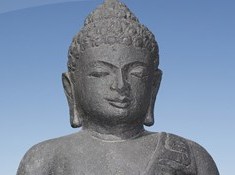Articles
-
The Four Noble Truths (the Words of the Buddha)
The Four Noble Truths
 The Buddha said: “It is through not understanding, not realizing four things that I, Disciples, as well as you, had to wander so long through this round of rebirths. And what are these four things? They are:
The Buddha said: “It is through not understanding, not realizing four things that I, Disciples, as well as you, had to wander so long through this round of rebirths. And what are these four things? They are:
The Noble Truth of Suffering
The Noble Truth of the Origin of Suffering
The Noble Truth of the Extinction of Suffering
The Noble Truth of the Path that leads to the Extinction of Suffering
As long as the absolutely true knowledge and insight regarding these Four Noble Truths was not quite clear in me, so long was I not sure that I had won that supreme Enlightenment which is unsurpassed in all the world with its heavenly beings, evil spirits and gods, amongst all the hosts of ascetics and priests, heavenly beings and men. But as soon as the absolute true knowledge and insight as regards these Four Noble Truths had become perfectly clear in me, there arose in me the assurance that I had won that supreme Enlightenment unsurpassed. And I discovered that profound truth, so difficult to perceive, difficult to understand, tranquillising and sublime, which is not to be gained by mere reasoning, and is visible only to the wise. The world, however, is given to pleasure, delighted with pleasure, enchanted with pleasure. Truly, such beings will hardly understand the law of conditionality, the Dependent Origination of everything; incomprehensible to them will also be the end of all formations, the forsaking of every substratum of rebirth, the fading away of craving, detachment, extinction, Nibbāna. Yet there are beings whose eyes are only a little covered with dust: they will understand the truth.”
Source: Taken from Digha Nikāya 16, Samyutta Nikāya LVI.11, Majjhima Nikāya 26, translated and compiled by Ven. Nyanatiloka in The Word of the Buddha, BPS, Kandy.
Photo Credit: Intellimon Ltd.
-
For a PDF copy, please click on The Four Noble Truths.
-
For an MS Word copy, click on The Four Noble Truths.
Two Sets of Cause and Effect
 One of the key beliefs in Buddhism is that nothing comes into being without a cause, and this law of cause and effect is a fundamental point for understanding the Four Noble Truths. The following table shows two sets of cause and effect: suffering as a result of the origin of suffering, and cessation as the result of the path.
One of the key beliefs in Buddhism is that nothing comes into being without a cause, and this law of cause and effect is a fundamental point for understanding the Four Noble Truths. The following table shows two sets of cause and effect: suffering as a result of the origin of suffering, and cessation as the result of the path.
| Result | Cause | |
| Problem | 1. Suffering | 2. Origin |
| Solution | 3. Cessation | 4. Path |
Although these two sets of cause and effect are very specific, they follow the rule of all cause-and-effects, and in particular the type of cause and effect called karma in Buddhism. Karma is an often misunderstood concept. To clarify, natural changes such as planetary rotation or plant growth are not the results of karma. Karma always relates solely to the workings of the mind. Only when there has been some sort of mental action, some sort of intention or volition, does the specific chain reaction of cause and result occur, and thus it is always associated with our mind state, our feelings or emotions. In the first set, the Truth of Origin is the cause, and the Truth of Suffering is the result. It is easy enough to see that both suffering and where it comes from have very much to do with human feelings and emotions. In the second set, the Truth of the Path is the cause, and the Truth of Cessation is the result. This might not be quite so obvious, but again, result and cause are very much connected with our human feelings and emotions. Cessation and path are inextricably intertwined. Source: Based on Tsering, Geshe Tashi. The Four Noble Truths: The Foundation of Buddhist Thought (Volume 1). Boston: Wisdom Publications, 2005. Pages 17-18.
 The Nobility of the Four Noble Truths
The Nobility of the Four Noble Truths
The most common and widely known formulation of the Buddha’s teaching is that which the Buddha himself announced in the First Sermon at Benares, the formula of the Four Noble Truths. The Buddha declares that these truths convey in a nutshell all the essential information that we need to set out on the path to liberation. He says that just as the elephant’s footprint, by reason of its great size, contains the footprints of all other animals, so the Four Noble Truths, by reason of their comprehensiveness, contain within themselves all wholesome and beneficial teachings. However, while many expositors of Buddhism have devoted attention to explaining the actual content of the four truths, only rarely is any consideration given to the reason why they are designated noble truths. Yet it is just this descriptive word “noble” that reveals to us why the Buddha chose to cast his teaching into this specific format, and it is this same term that allows us to experience, even from afar, the unique flavor that pervades the entire doctrine and discipline of the Enlightened One. The word “noble,” or ariya, is used by the Buddha to designate a particular type of person, the type of person which it is the aim of his teaching to create. In the discourses the Buddha classifies human beings into two broad categories. On one side there are the puthujjanas, the worldlings, those belonging to the multitude, whose eyes are still covered with the dust of defilements and delusion. On the other side there are the ariyans, the noble ones, the spiritual elite, who obtain this status not from birth, social station or ecclesiastical authority but from their inward nobility of character. These two general types are not separated from each other by an impassable chasm, each confined to a tightly sealed compartment. A series of gradations can be discerned rising up from the darkest level of the blind worldling trapped in the dungeon of egotism and self-assertion, through the stage of the virtuous worldling in whom the seeds of wisdom are beginning to sprout, and further through the intermediate stages of noble disciples to the perfected individual at the apex of the entire scale of human development. This is the arahant, the liberated one, who has absorbed the purifying vision of truth so deeply that all his defilements have been extinguished, and with them, all liability to suffering. While the path from bondage to deliverance, from worldliness to spiritual nobility, is a graded path involving gradual practice and gradual progress, it is not a uniform continuum. Progress occurs in discrete steps, and at a certain point — the point separating the status of a worldling from that of a noble one — a break is reached which must be crossed, not by simply taking another step forward, but by making a leap, by jumping across from the near side to the further shore. This decisive event in the inner development of the practitioner, this radical leap that propels the disciple from the domain and lineage of the worldling to the domain and lineage of the noble ones, occurs precisely through the penetration of the Four Noble Truths. This discloses to us the critical reason why the four truths revealed by the Buddha are called noble truths. They are noble truths because when we have penetrated them through to the core, when we have grasped their real import and implications, we cast off the status of the worldling and acquire the status of a noble one, drawn out from the faceless crowd into the community of the Blessed One’s disciples united by a unique and unshakable vision. Prior to the penetration of the truths, however well endowed we may be with spiritual virtues, we are not yet on secure ground. We are not immune from regression, not yet assured of deliverance, not invincible in our striving on the path. The virtues of a worldling are tenuous virtues. They may wax or they may wane, they may flourish or decline, and in correspondence with their degree of strength we may rise or fall in our movement through the cycle of becoming. When our virtues are replete we may rise upward and dwell in bliss among the gods; when our virtues decline or our merit is exhausted we may sink again to miserable depths. But with the penetration of the truths we leap across the gulf that separates us from the ranks of the noble ones. The eye of Dhamma has been opened, the vision of truth stands revealed, and though the decisive victory has not yet been won, the path to the final goal lies at our feet and the supreme security from bondage hovers on the horizon. One who has comprehended the truths has changed lineage, crossed over from the domain of the worldlings to the domain of the noble ones. Such a disciple is incapable of regression to the ranks of the worldling, incapable of losing the vision of truth that has flashed before his inner eye. Progress toward the final goal, the complete eradication of ignorance and craving, may be slow or rapid; it may occur easily or result from an uphill battle. But however long it may take, with whatever degree of facility one may advance, one thing is certain: such a disciple who has seen with immaculate clarity the Four Noble Truths can never slide backward, can never lose the status of a noble one, and is bound to reach the final fruit of arahantship in a maximum of seven lives. The reason why the penetration of the Four Noble Truths can confer this immutable nobility of spirit is implied by the four tasks the noble truths impose on us. By taking these tasks as our challenge in life — our challenge as followers of the Enlightened One — from whatever station of development we find ourselves beginning at, we can gradually advance toward the infallible penetration of the noble ones. Source: “The Nobility of the Truths”, by Bhikkhu Bodhi. Access to Insight (Legacy Edition), 5 June 2010, http://www.accesstoinsight.org/lib/authors/bodhi/bps-essay_20.html
16 Characteristics of the Four Noble Truths
 The Mahayana text Ornament of Clear Realization (Abhisamayalamkara) identifies four characteristics of each Noble Truth, for a total of sixteen characteristics, which are presented as a guide to contemplating and practicing the Four Noble Truths. The Ornament of Clear Realization is a key text in the curriculum of Tibetan Buddhist monasteries and study colleges, and this method of study and practice is emphasized in the Tibetan tradition.
The Mahayana text Ornament of Clear Realization (Abhisamayalamkara) identifies four characteristics of each Noble Truth, for a total of sixteen characteristics, which are presented as a guide to contemplating and practicing the Four Noble Truths. The Ornament of Clear Realization is a key text in the curriculum of Tibetan Buddhist monasteries and study colleges, and this method of study and practice is emphasized in the Tibetan tradition.
These sixteen characteristics are identified as follows:
- Truth of suffering – these characteristics refer to the five aggregates
- impermanence – the five aggregates* are impermanent and change from moment to moment
- suffering – the five aggregates have come into being because of avidya* (ignorance) and kleshas* (disturbing emotions), and they are under the influence of the avidya and kleshas
- emptiness – there is no “self” outside of the five aggregates that controls or makes use of the five aggregates
- selflessness – there is no “self” to be found within the five aggregates that controls or makes use of the five aggregates
- Truth of origin – these characteristics refer to karma*, kleshas, and avidya
- causes – karma, kleshas, and avidya are constantly arising within our mental continuum, and because of their nature they have the quality of being the causes of suffering.
- origin – kleshas and karma are the actual origin of suffering, not just intermediate links.
- strong production – avidya, kleshas, and karma act forcefully as the main causes of suffering (they are not just passive ingredients)
- condition – avidya, kleshas, and karma are more than just the main causes of suffering, they are also the contributory causes
- Truth of cessation – these characteristics refer to cessation
- cessation – cessation is the ceasing of all kleshas and avidya forever
- pacification – cessation pacifies the torment of suffering, and brings true peace
- being superb – cessation is supreme in bringing about the source of all health and happiness
- definite emergence – cessation will definitely bring us out of samsara*
- Truth of the path – these characteristics refer to the path
- path – the path leads to cessation
- awareness – the path leads us to a full and complete understanding of the root of cyclic existence (samsara) and the means to escape it
- achievement – through the path, we can definitely achieve the result of liberation and enlightenment
- deliverance – the path delivers us from the bondage of our conditioned existence
Definitions (marked * above):
avidya (Skt.): ignorance, which is generally divided into two types: ignorance of causality and ignorance of ultimate nature.
five aggregates: the traditional way to break down a person into psychophysical components. The aggregates are form (body), feeling, discrimination, compositional factors, and consciousness (mind).
karma (Skt.): action; the natural law of cause and effect whereby positive actions produce happiness and negative actions produce suffering.
klesha (Skt.): delusions – the combination of ignorance and the afflictive emotions of attachment and aversion.
samsara (Skt.): cyclic existence, the state of constantly taking rebirth due to delusion and karma.
Sources: http://en.wikipedia.org/wiki/Four_Noble_Truths#Sixteen_characteristics Tsering, Geshe Tashi. The Four Noble Truths: The Foundation of Buddhist Thought (Volume 1). Boston: Wisdom Publications, 2005.
- For a PDF copy, click on Sixteen Characteristics of the Four Noble Truths.
- For an MS Word copy, click on Sixteen Characteristics of the Four Noble Truths.
